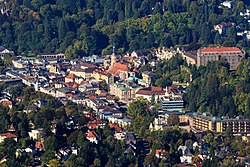Baden-Baden
| Baden-Baden | ||
|---|---|---|

View of Baden-Baden from Mount Merkur.
|
||
|
||
| Coordinates: 48°45′46″N 08°14′27″E / 48.76278°N 8.24083°ECoordinates: 48°45′46″N 08°14′27″E / 48.76278°N 8.24083°E | ||
| Country | Germany | |
| State | Baden-Württemberg | |
| Admin. region | Karlsruhe | |
| District | Urban district | |
| Government | ||
| • Mayor | Margret Mergen (CDU) | |
| Area | ||
| • Total | 140.18 km2 (54.12 sq mi) | |
| Population (2015-12-31) | ||
| • Total | 54,160 | |
| • Density | 390/km2 (1,000/sq mi) | |
| Time zone | CET/CEST (UTC+1/+2) | |
| Postal codes | 76530–76534 | |
| Dialling codes | 07221, 07223 | |
| Vehicle registration | BAD | |
| Website | baden-baden.de | |
Baden-Baden is a spa town, located in the state of Baden-Württemberg in southwestern Germany. It lies at the northwestern border of the Black Forest mountain range on the small river Oos, just 10 km (6 mi) east of the Rhine, the border line to France, and about 40 km (25 mi) north-east of Strasbourg, France.
The springs at Baden-Baden were known to the Romans as Aquae ("The Waters") and Aurelia Aquensis ("-of-the-Waters") after M. Aurelius Severus Alexander Augustus.
In modern German, is a gerund meaning "bathing" but Baden, the original name of the town, derives from an earlier plural form of (""). (The modern plural has become .) As with the English placename "Bath", there are at hot springs throughout Central Europe. The current doubled name arose to distinguish it from the others, particularly Baden near Vienna in Austria and Baden near Zürich in Switzerland. It is a reference to the Margraviate of Baden-Baden (1535–1771), a subdivision of the Margraviate of Baden, the territory named after the town. Baden-Baden became its formal name in 1931.
...
Wikipedia


